While no content marketing tool can replace a solid strategy and talented humans, having the right tech stack can certainly help you get the job done better, easier, and more efficiently.
There are hundreds of content marketing tools available, some free or cheap and some very expensive. They also serve tons of different purposes, from content ideation to production to promote, optimization, and more. The content marketing technology landscape is growing every year.
This is exciting, since it means that if you have a problem, you can probably find a software solution to help you solve it. But it’s also overwhelming. How do you know which of the couple hundred tools are worth trying?
This post will help clarify those decisions for you. We’ll outline the top 19 content marketing tools in 2019.
The 19 Best Content Marketing Tools in 2019
- HubSpot
- WordPress
- Google Docs
- Airstory
- Grammarly
- Yoast
- Buzzsumo
- Ahrefs
- Vidyard
- Loom
- Trello
- Airtable
- Google Analytics
- HotJar
- Google Optimize
- Mutiny
- The Stocks.IM
- Canva
- Adobe Photoshop
1. HubSpot
HubSpot offers many content marketing tools, and many of them are free to try. These include:
- A powerful form builder
- Popup tools
- Live chat and chatbots
- And all-in-one WordPress plugin for marketing
In addition to free content marketing tools, if you really want to build a growth machine, HubSpot has a world-class CMS and the most powerful marketing automation platform in the industry and allows you to centralized everything to a free CRM. This means that, at each and every level of a company’s growth, HubSpot has some solution that can help you build your content marketing program.
HubSpot also makes products for sales and service teams. As such, it can really be the ground control for your whole business.
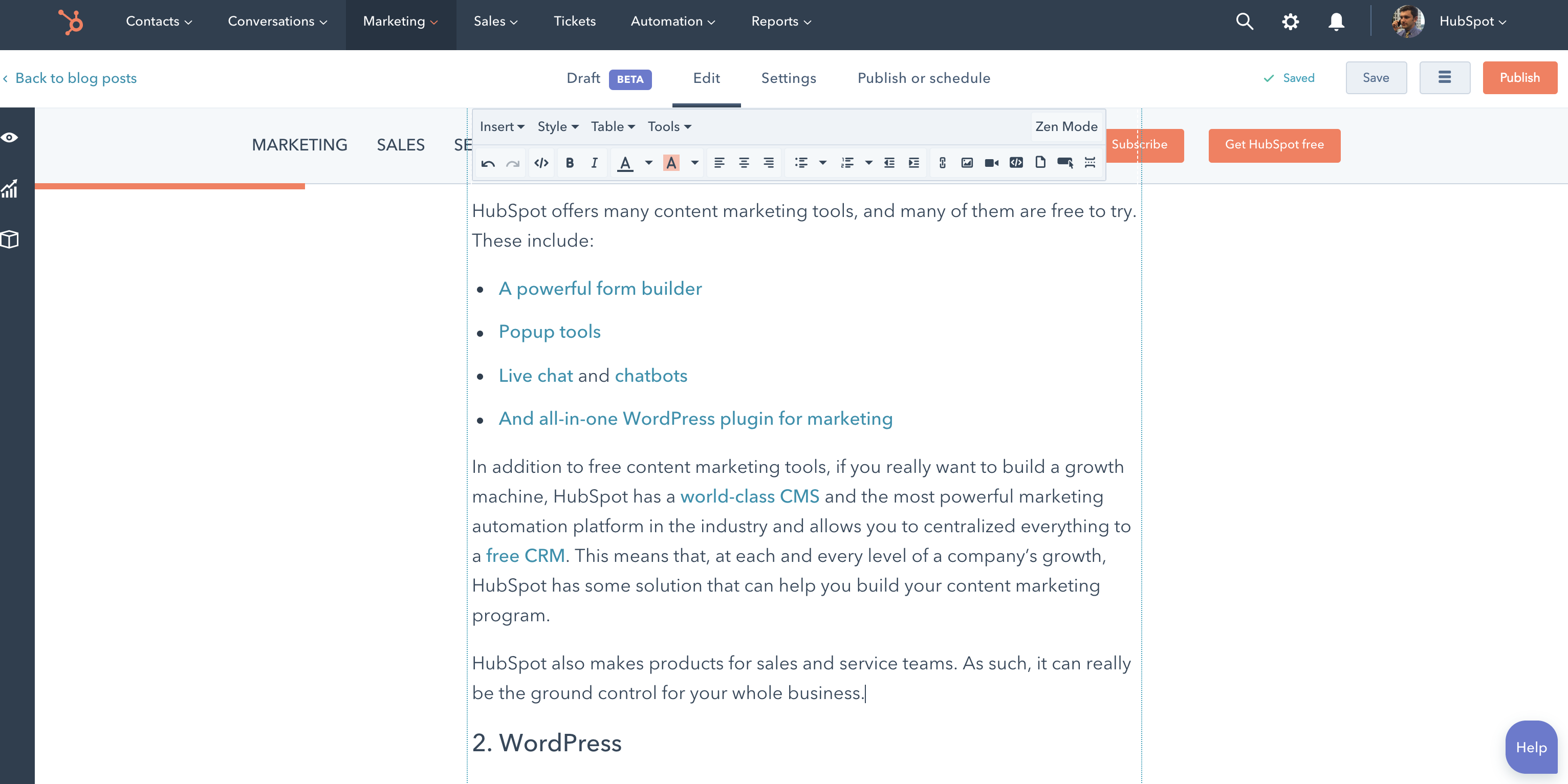
Meta, right?
2. WordPress
WordPress is the most widely used CMS in the world. As of August 2018, VentureBeat reported that WordPress powers about 30% of the internet in general.
Social proof can sometimes lead us astray, but in this case, it turns out that WordPress is a pretty powerful tool, both at the beginning stages and as your grow your content marketing program (it’s used by sites like The New Yorker and The Next Web)
At its core, WordPress is an open source CMS that allows you to host and build websites. You can self-host or host your site via WordPress.com. WordPress contains plugin architecture and a template system so you can customize any website to fit your business, blog, portfolio, or online store.
It’s a highly customizable platform and is widely used by bloggers.
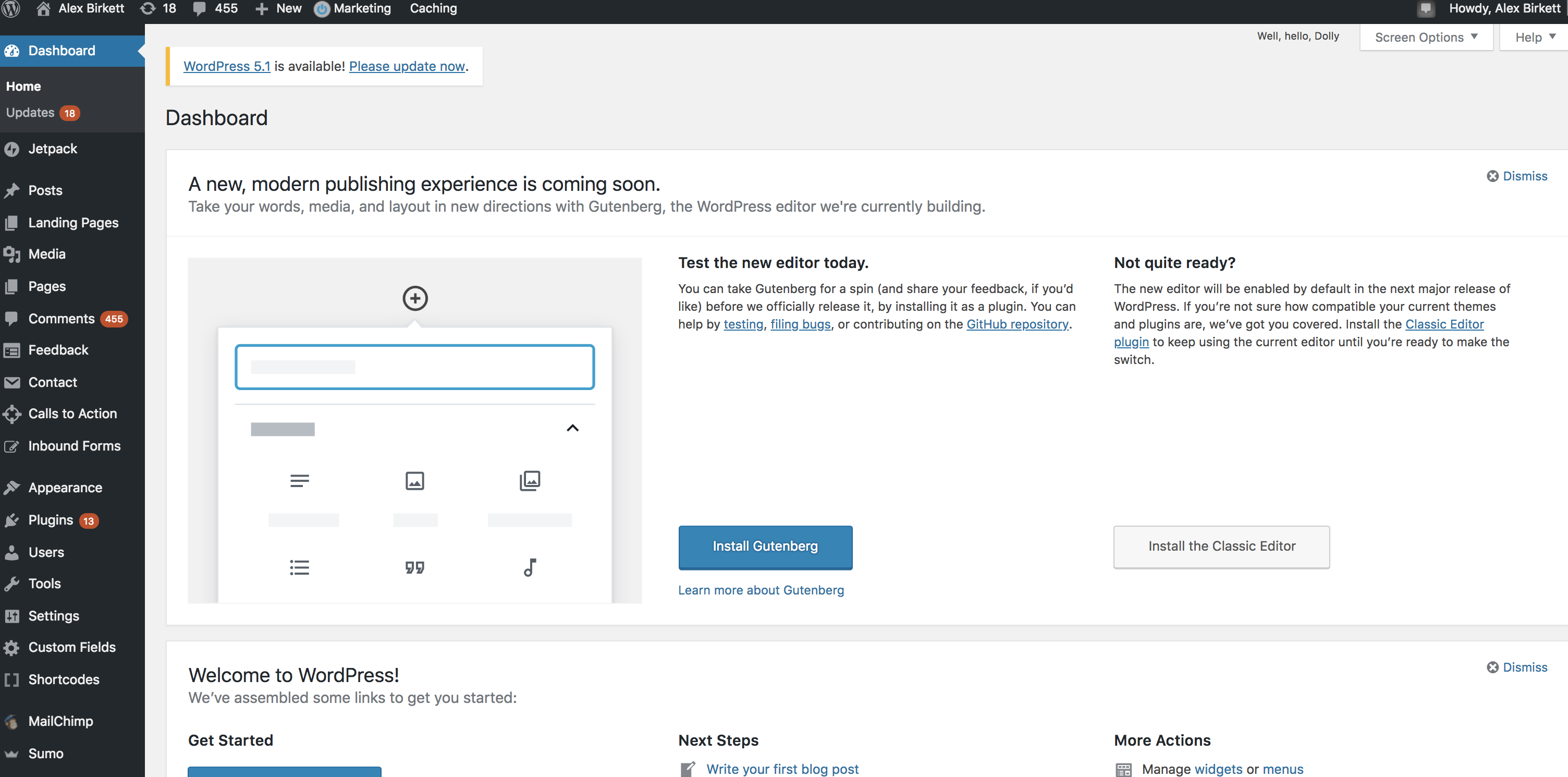
3. Google Docs
Google Docs is to content marketing what a kitchen is to chefs: it’s where all of the work gets done before the final presentation.
Personally, I don’t know any content marketers who don’t use Google Docs to draft their articles. It’s the best platform for collaboration by a long shot, but it’s also easy to use has a pleasant user experience.
In addition, you can usually find a way to upload Google Docs directly to your CMS. In the case of HubSpot, you can do that by default. If you use WordPress, you can use a tool like Wordable to help you out.
Google Docs is free, quite ubiquitous, and pleasant to use. Not many reasons not to use it.
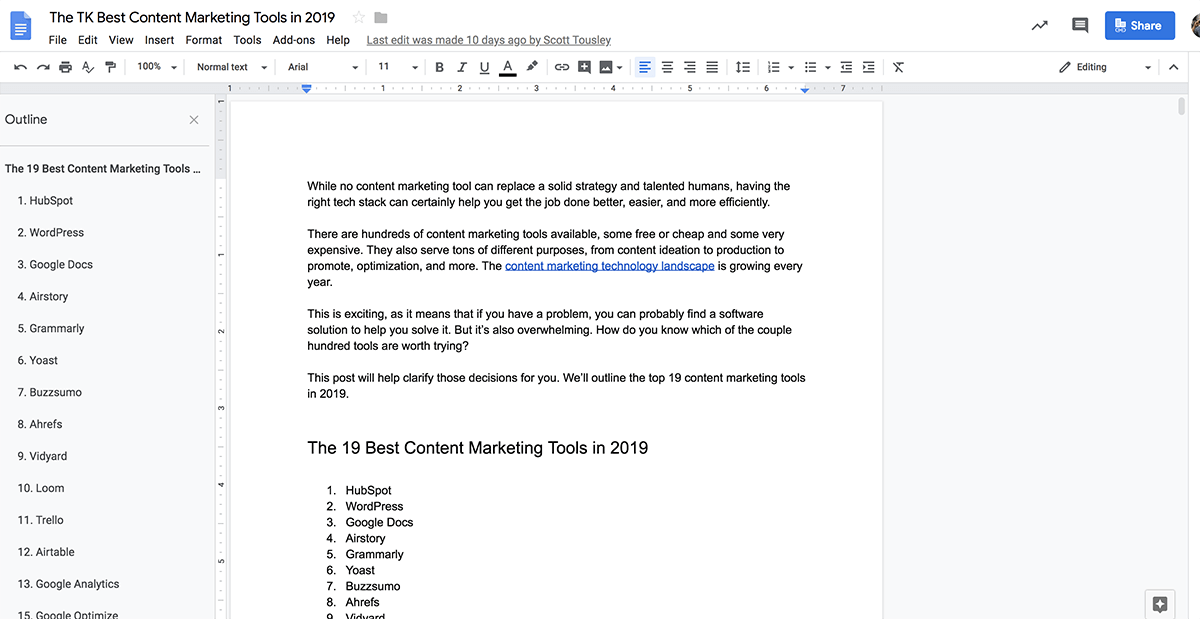
4. Airstory
If you do want to step up your writing and collaboration game, Airstory is a more powerful platform for writers. If you find yourself moving too often between Evernote, Google Docs, Google Drive, and you always seem to have a hundred tabs open for research, it might be time to look into Airstory.
It helps you save quotes, images, and multimedia and drag and drop it into any application where you do writing. As such, it’s an incredible tool for collaboration, but also for writers who are working on longer form content (such as books or ebooks).
5. Grammarly
Grammarly has changed the game for me. I’m not naturally what you would call “detail-oriented,” so if it weren’t for talented editors, you’d be tearing me apart right now for the multitude of grammar mistakes littering my articles.
Grammarly, however, reduces my error rate by probably 50-80%. I still have some mistakes slip through, but to a large extent, Grammarly saves me from embarrassment (not just when writing articles, by the way - it also works for social media and forum comments).
6. Yoast
Yoast is one of my favorite tools for writing SEO-focused content.
It’s a sort of “all-in-one” WordPress plugin for SEO that helps do pretty much everything, including optimizing content for a keyword, previewing and editing meta-descriptions and URL slugs, abstracting away technical SEO tasks, and suggesting relevant internal links.
They have over 9,000,000 downloads, 4.9 out of 5 stars in the WordPress marketplace, and just anecdotally, everyone I know who uses WordPress uses Yoast. It’s just a great plugin.
7. Buzzsumo
Buzzsumo is a great multi-purpose content marketing research tool.
One of the main things it can do is help you analyze what content performs best for any topic or competitor. You can see metrics like social shares, backlinks, and which influencers are sharing as given piece of content.
They also have great influencer reports so you can see who the thought leaders are for a given topic area.
8. Ahrefs
Ahrefs is my personal favorite SEO tool, and I use it just about every day. It’s great for everything from tracking the rankings of your keywords to analyzing your competitors’ keywords and traffic and much more.
Everytime I think I’ve mastered the full functionality of Ahrefs, I find a new feature that surprises and delights me. The basics, such as keyword research or site analyzer, are wonderful. But I also love reports like “top pages” (where you can analyze the most valuable pages on a website), or “content gap” (where you can see what competitors rank for that you don’t).
9. Vidyard
Vidyard is a video marketing platform that helps you host, share, and promote video content on your website.
They have a sales solution as well to help you close more accounts, but the marketing solution is what I’m most used to. Vidyard’s video analytics are robust, you can run A/B tests and personalize videos, and you can even gate videos at a certain time length to help capture leads.

10. Loom
Loom is a tool that I’ve more recently begun using, but at this point it’s a staple for me.
It’s a simple tool, but one with powerful use cases, even beyond content marketing. What it does is allow you to create, edit, and share screen share videos. For content marketing, I love this, because I can create and embed tutorials for technical walkthroughs.
Organizationally, I love it as well. It’s great for communicating quick questions or explaining concepts to other team members (without requiring a full, synchronous meeting).
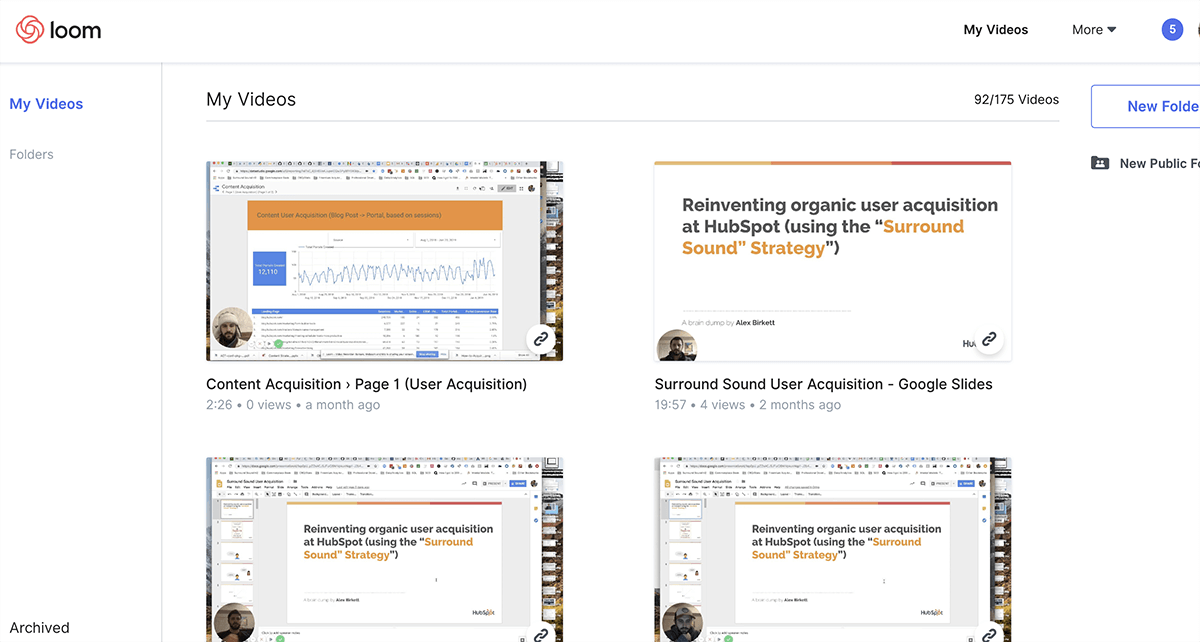
11. Trello
When you really start producing content, you’ll need some way to manage the process. This is particularly true if you’re working with many staff writers or guest writers.
My favorite tool for this is Trello.
Trello is a simple kanban and project management tool, which means it can be used for many purposes. In fact, I’ve used it for tons of things, like growth experiments, sales pipelines, and product feature roadmaps.
But I really like it as an editorial calendar tool.
12. Airtable
Airtable is another project management tool, though it’s a little more complicated (though also customizable). It’s kind of like a mixture between spreadsheets and Trello. Again, with Airtable, the use cases are many, but I really like it for two content marketing purposes:
- Editorial calendars
- Influencer/writer management
I’ve also used Airtable for several other things in the past, including growth experiments and general team operating documents.
13. Google Analytics
When talking about content marketing tools, you can’t leave measurement out of the discussion.
Surely, you can get some good insights from SEO tools like Google Search Console as well as previously listed tools like Ahrefs. But you’ll also want a digital analytics platform so you can track business metrics.
Google Analytics is one of the most widely used platforms online. It’s easy-to-use (at least the basic configurations), and it’s free. Two big benefits.
However, it’s also very powerful if you’re technical and know how to setup a proper configuration. You can not only track goals, like form submissions or product purchases, but you can also set up behavioral events, like scroll-depth.
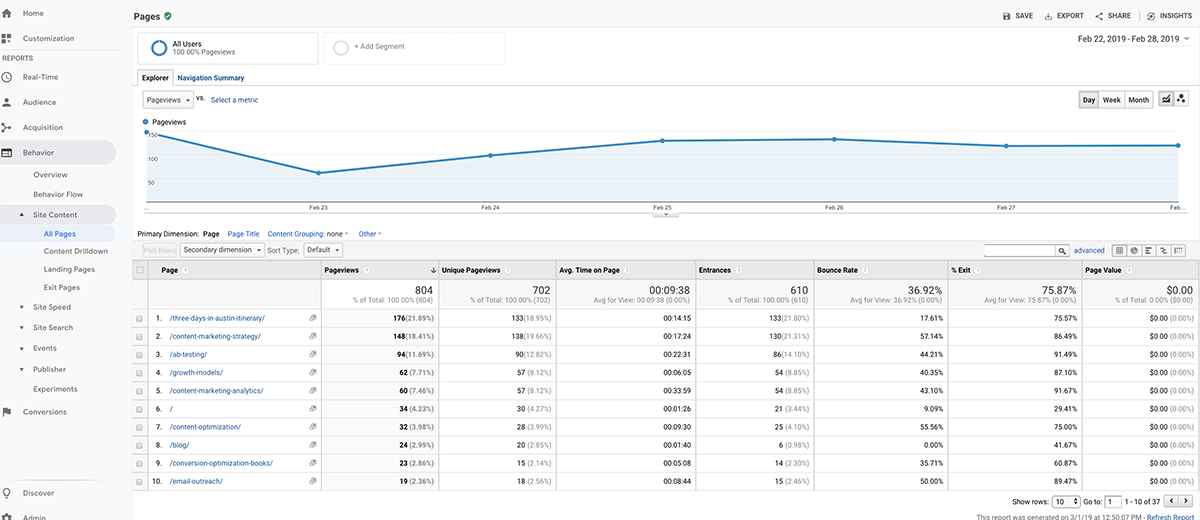
14. HotJar
HotJar is my favorite user experience analytics tool. It’s got some qualitative tools, such as on-site poll, surveys, and session replays. Where Google Analytics can help you uncover the “what” and “where” of user behavior, these tools can help you start to tiptoe into the “why.”
In addition, they also provide some quantitative tools such as heat maps. These allow you to get a good visual picture of where you visitors are clicking and scrolling.
One use case I love HotJar (outside of CRO) for is to source interesting content ideas:
15. Google Optimize
We’ve got a quantitative digital analytics tool (Google Analytics) and a qualitative insights platform (HotJar), so we presumably can know a lot about our readers and our website at this point. But what if we want to make a change to our blog or landing pages?
My background is in optimization, so if there’s sufficient traffic, I like to set up A/B tests for site changes.
There are many tools out there for this, but I wanted to list Google Optimize because it’s free. It’s also a good starter option to get used to. If you do want to explore other options, here’s a good article comparing the market solutions. But Google Optimize is a great start.
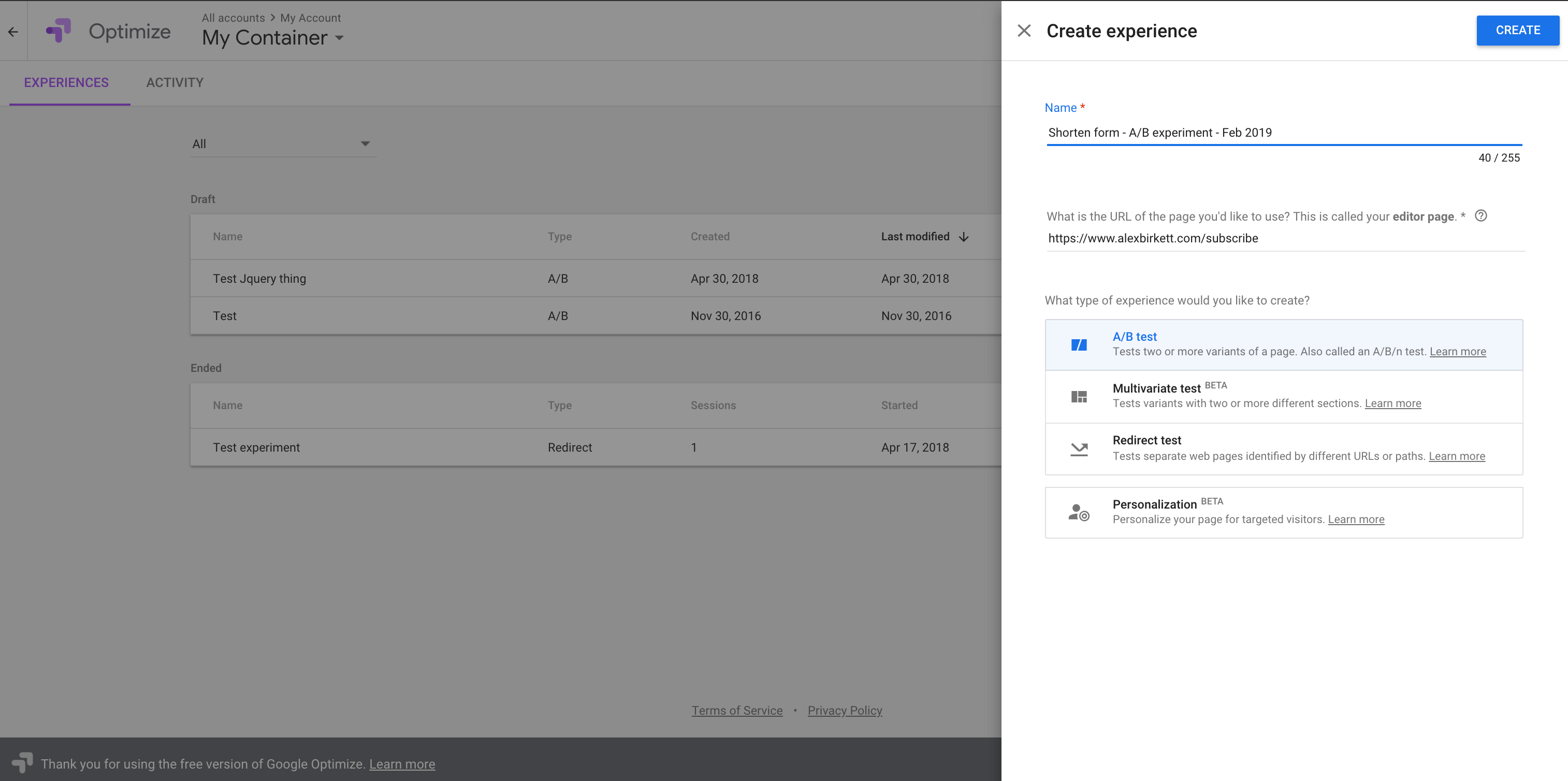
16. Mutiny
A/B testing is one thing; personalization is also an interesting avenue to explore.
Where A/B testing is a controlled experiment with a limited time-horizon, personalization allows you to deliver different unique experiences to subsets of your overall audience.
For example, you could target mobile users with different popup forms. Or you could target visitors who have read three blog posts with an offer for a specific e-book. Or you could target people who scroll 75% of the way down a certain blog post with an in-text CTA.
The options are endless, only limited by your time, resources, creativity, and prioritization.
Anyway, Mutiny is my favorite platform in this space. It’s designed for B2B, so if you’re in ecommerce you may want to look at another tool like Evergage. But Mutiny is a good and promising newer player with lots of functionality.

17. TheStocks.IM
Most good content marketing includes imagery, so it only makes sense to include a stock photo site here in our list of content marketing tools.
I like TheStocks.IM because it aggregates several free stock photo sites, including Unsplash (my favorite) and Pixabay.
18. Canva
What about when a stock image doesn’t cut it, and you want to make your own imagery?
Canva is a great option here.
With Canva, you really don’t need to have excellent graphic design skills. I’m a horrible designer, and I can make decent looking graphics with Canva. It’s really designed for the layperson.
This tool is great for all kinds of content marketing imagery, like social media images, blog cover photos, Twitter cover photos, etc. It’s pretty all-purpose.

19. Adobe Photoshop
Now, what if you want to make your own imagery, but you actually are good at graphic design?
Well, in this case, Photoshop is the gold standard. It’s great for editing photographs as well as creating images such as Facebook photos, blog cover photos, and even screenshot tutorials.
I find that, just as with SQL, little bit of skill with Photoshop goes a long way.
 Not all of the content marketing tools on this list are free, though many of them are.
Not all of the content marketing tools on this list are free, though many of them are.
As such, if you're a content marketer on a budget, look into the following tools, which can all be used or at least tested out for free.
13 Free Content Marketing Tools in 2019
- HubSpot
- WordPress
- Google Docs
- Grammarly
- Yoast
- Loom
- Trello
- Airtable
- Google Analytics
- HotJar
- Google Optimize
- The Stocks.IM
- Canva
Content marketing tools won’t save a bad content strategy or a bad product
... but they’ll certainly help you get the job done faster and more effectively.
Obviously there are many more content marketing tools out there, but for this list, I tried to only list those that you really need as well as the tools that I like the most.
from Marketing https://blog.hubspot.com/marketing/content-marketing-tools
Grammarly website makes me think I'm in kindergarten again.. My colleague overheard me complaining in the break room and turned me on to INK, I really appreciate how non-invasive it is. I like the suggestions a lot plus are convinced they more useful.
ReplyDeleteI’m done with plugins. Now, I use Ink for all, this word processor with a built-in AI that helps optimize content. Who else has tried it? http://bit.ly/2XUjrhu
ReplyDeleteHAI
ReplyDeleteThis is a great resource and very thorough! Great article. Newest tool that I don’t see mentioned is a free one called INK for All. Between cranking out upwards of 6 blog posts 5 days a week and looking after my family, relying on just one content creation tool is amazing. So far, so good. Another good tool for my tool box, I wanted to share this app with you here: https://seo.app/XzTXZsUH9
Thanks for the update, one of the biggest problems I am having on my site is what you just talked about here right now. I really don't know how I can improve in my content to attractive content that will bring visitors to my website @tecteem. Can you help out, although I read through the article you have provided here for us. But I really want to make my toxicwap content to improve more than the way it is now.
ReplyDelete